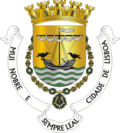Lisbon
Lisbon (Portuguese: [Lisboa] Error: {{Lang}}: text has italic markup (help)) is the capital city of Portugal. It is the largest city of Portugal. The city has a population of about half million people. In Lisbon's urban area live around 2.8 million people, being the 10th-most populous urban area in the European Union.[2] Lisbon is placed on the right bank (western) of the Tagus River, near the outfall. It has a pleasant climate and has about 220 days of sunshine each year. There are many beautiful beaches close to the city. There are also many seafood restaurants, historical sites and monuments, being one of the oldest cities in the world.[3]
|
Lisboa | |
|---|---|
 | |
| Etymology: Lisboa, Portuguese derivative of Latin Ulyssippo after Ulysses; and/or Roman Olissipona, for the name of the Tagus | |
|
| |
|
| |
| Anthem: Marcha a Lisboa | |
| Coordinates: 38°43′31″N 9°09′00″W / 38.7252668°N 9.1500193°WCoordinates: 38°43′31″N 9°09′00″W / 38.7252668°N 9.1500193°W | |
| Country | Portugal |
| Metro | Lisbon metropolitan area |
| District | Lisbon |
| Historic province | Estremadura |
| Settlement | c. 1200 BCE |
| Roman Olissipo | c. 138 BCE |
| Moorish rule | 711 CE |
| Siege of Lisbon | 1147 CE |
| Civil parishes | (see text) |
| Government | |
| • Type | LAU |
| • Body | Concelho/Câmara Municipal |
| • Mayor | Carlos Moedas |
| • Municipal chair | Helena Roseta |
| Area | |
| • Capital city | 100.05 km2 (38.63 sq mi) |
| Elevation | 2 m (7 ft) |
| Population (2017) | |
| • Capital city | 505,526[1] |
| • Urban | 2,700,000 |
| • Metro | 2,827,514[1] |
| Time zone | UTC (WET) |
| • Summer (DST) | UTC+1 (WEST) |
| Postal zone | 1149-014 Lisboa |
| Patron saint | Vincent of Saragossa and Anthony of Lisbon |
| Municipal address | Praça do Município, 1 1149-014 Lisboa |
| Municipal holidays | 13 June (St. Anthony's Day) |
| Website | www.cm-lisboa.pt |
Geography
Civil parishes
The municipality of Lisbon have 24 freguesias (civil parishes).[4]
Transportation
Metro

The Lisbon Metro connects the city centre to different districts, it also reaches some suburbs around the Lisbon metropolitan area, like Amadora and Loures.
Trams
Trams are a traditional public transport in Lisbon. It was first introduced in 1901, many of the electric trams were originally imported from the US,[5] and were called americanos. Trams in Lisbon are coloured yellow and is one of the tourist icons of the city, and their size is great for steep hills and narrow streets of the central city.[6][7]
Lisbon Media
Phoenician archaeological dig in a cloister of the Lisbon Cathedral
The oldest known panorama of Lisbon (1500–1510) from the Crónica de Dom Afonso Henriques by Duarte Galvão
King Manuel I ordered Jerónimos Monastery to be built in Belém, to serve Portuguese discoverers.
Ribeira Palace and the Terreiro do Paço depicted in 1662 by Dirk Stoop
The Palace of Ajuda was built as a residence for the King of Portugal following the 1755 Lisbon Earthquake.
The Proclamation of the Portuguese Republic in 1910
Monument of the Discoveries was built for the 1940 Portuguese World Exhibition.
References
- ↑ 1.0 1.1 "PORDATA - População residente: Total e por grandes grupos etários". Archived from the original on 2019-06-30. Retrieved 2019-09-20.
- ↑ Demographia: World Urban Areas - demographia.com, 06.2021
- ↑ H. V. Livermore (1973). Portugal: A Short History. Edinburgh University Press. p. 4. ISBN 978-0-85224-207-0.
- ↑ Diário da República. "Law nr. 56/2012, pages 6454–6460" (pdf) (in português). Archived from the original on 29 November 2014. Retrieved 20 November 2014.
- ↑ Electrical World. McGraw-Hill. 1900. p. 566.
- ↑ [1] Archived 3 January 2007 at the Wayback Machine Information from Carris, Lisbon transportation company.
- ↑ "Luso Pages - Lisbon (Portugal) Trams". Archived from the original on 15 May 2011. Retrieved 10 March 2011. Details of Lisbon's trams, from Luso Pages
Other websites
- Official page of the city Archived 1998-11-11 at the Wayback Machine (in Portuguese)
- Lisbon Photos a collection of Photos, showing Lisbon as it is to visitors.
| Wikimedia Commons has media related to Lua error in Module:Commons_link at line 62: attempt to index field 'wikibase' (a nil value).. |











